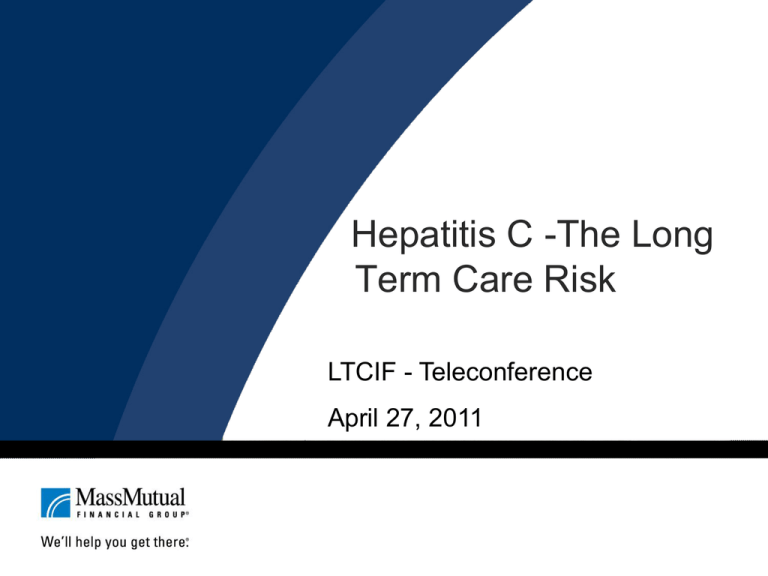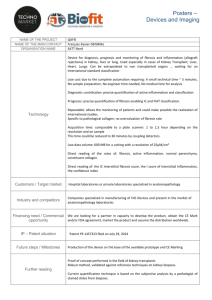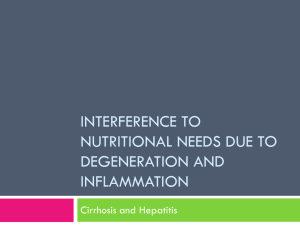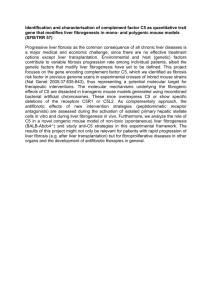Hepatitis C -The Long Term Care Risk LTCIF - Teleconference April 27, 2011
advertisement

Hepatitis C -The Long Term Care Risk LTCIF - Teleconference April 27, 2011 Objectives • • • • • Basics of the disease Disease progression Comorbid factors Treatment Long term care risk Basics of Hepatitis C • Caused by an RNA virus • Clinical Course – Acute • 5 weeks from infection • Increased SGOT, SGPT – Chronic • Defined as infection for more than 6 months • Acute becomes chronic ~ 85% of the time Hepatitis C – Case #1 • 62 yo M applying alone for comprehensive coverage $200/d, 5yr BP, 90 d EP • Mild ^ ALT/AST for many years • Hepatitis C diagnosed by Hepatitis C Ab + • Had transfusion in his 30’s after an accident Hepatitis C – Case #1 cont’d • Age 56 (2004) – liver biopsy: –Mild inflammation, no fibrosis • Age 60 (2008) repeat liver biopsy: –Grade 1 inflammation (activity) –Stage 2 fibrosis – portal fibrosis with some septal fibrosis • Genotype 1b • Treatment begun with pegylated interferon and ribavirin • 4 weeks – viral RNA load undetectable, AST/ALT normalized Hepatitis C – Case #1 cont’d • Treated for 48 weeks • Hepatitis C RNA by PCR negative at 6 months after treatment completed • AST/ALT continue to be normal • Serum albumin above 4.0 Hepatitis C – Transmission Had transfusion in his 30’s after an accident • Transfusion prior to blood pool testing for Hep C ~1990 • IV drug use • Cocaine (intranasal) • Multiple sexual partners • Tattoos • Acupuncture • Razor sharing • Needle stick injury (health care providers) • Unknown (~10%) Liver Biopsies • Age 56 (2004) – liver biopsy: – Mild inflammation, no fibrosis – Grade 1, Stage 0 • Age 60 (2008) repeat liver biopsy: – Grade 1 inflammation (activity) – Stage 2 fibrosis – portal fibrosis with some septal fibrosis Hepatitis C – Liver Biopsy Staging • Grade - degree of inflammation • Grades 1-4 (a little to a lot) • Stage – degree of fibrosis • • • • • 0: No fibrosis 1: Portal fibrosis 2: Periportal fibrosis/rare septal fibrosis 3: Septal fibrosis/bridging fibrosis 4: Cirrhosis Grade of Liver Inflammation Grade Description Degree of Interface Hepatitis (Piecemeal necrosis) Degree of Lobular Inflammation 0 Portal inflammation only, no necrosis None None 1 Minimal necrosis Minimal, patchy Minimal, patchy 2 Mild necrosis Mild involving some or all portal tracts Mild hepatocellular damage 3 Moderate necrosis Moderate involvement of all portal tracts Moderate, noticeable hepatocellular damage 4 Severe necrosis Severe with bridging necrosis Severe, diffuse hepatocellular damage Stage of Liver Fibrosis Description Criteria 0 No fibrosis Normal connective tissue 1 Portal fibrosis Fibrous portal expansion Perisinusoidal fibrosis Consider as early Stage 1 if an isolated finding 2 Periportal fibrosis Periportal or rare portal to portal septa 3 Septal fibrosis Bridging fibrosis Portal to portal septa, bridging architectural distortion, no cirrhosis 4 Cirrhosis Extensive fibrosis with regenerative nodules Stage Liver Schematic Normal Liver Central Vein Portal Triad: Bile duct, hepatic artery, portal vein Cirrhosis Liver cells Bands of scar tissue surround groups of liver cells Hepatitis C – Progression Had transfusion in his 30’s Disease for 30+ years ? • Biopsy #1 Grade 1/Stage 0 • Mild disease especially after 30 years • ? Risk of progression • Do transaminases help predict degree of liver disease/progression? • NO • Biopsy #2 Grade 1/Stage 2 • More progression than would be expected • Why? Progression 10-20% cirrhosis in 20 yrs Decompensated cirrhosis -50% 5 yr survival 1-4% per year Int J Med Sci. 2006; 3(2): 47–52. Progression Predictors • • • • • • • Alcohol use (>3 drinks/d in males, >2/d in females) Excess iron stores Male Immunosuppression (HIV) Concomitant hepatitis (e.g.,Hepatitis B) Age of acquisition (> age 40) Other liver disease Progression Prediction • Dilemma – Is progression linear? – Is it level and then gets worse? – Is it level and stays on the same trajectory? – Is it level and then resolves? Semin Liver Dis. 2000;20(1) Recovery, Persistence, and Sequelae in Hepatitis C Infection: A Perspective on Longterm Outcome. Harvey J. Alter, MD and Leonard B. Seef, MD Hepatitis C Treatment • Medications – Pegylated interferon (injectable) – Ribavirin (tablets) • Treatment Regimens – 24 weeks – genotypes 2, 3 – 48 weeks – genotype 1b (most common in US) higher stages of fibrosis • Follow up with viral load looking for decreasing viral count Treatment Response Predictors • Genotype – Type 1a and b (most common in US) and type 4 (not very common) • Most resistant to current treatment (~45%) – Type 2 and 3 significant minority • More responsive to treatment (~85%) • • • • Initial viral load Degree of fibrosis Obesity Gender Treatment Goals • Sustained viral response (SVR) – No detectable viral RNA 6 months after treatment completed • Improvement in liver histology – Arrest or improve fibrosis Long Term Care Risk of Treatment • Treatment – Short term • Fatigue • Depression • Anemia – Long term • None known ? Effect on ADL’s Long Term Care Risk of Disease • Short term – Fatigue • Long term – Risk of relapse • Rare if at all – Risk of cirrhosis in this individual • Does fibrosis improve? • LTC risk if disease arrested – LTC risk of cirrhosis • • • • • • • Encephalopathy Upper GI bleeding Ascites Hepatocellular carcinoma Transplantation Sleep disturbance Pruritis Hepatitis C – Case #2 • 62 yo F $150/d comprehensive 90 d EP • Hx of long standing mild ^ ALT/AST (50-70/50-70, occasionally normal • Hx of Hepatitis C dx’ed 10-15 years ago with liver biopsy 10-15 years ago – minimal inflammation, no fibrosis • No treatment based on mild biopsy findings • Current labs: AST/ALT 62/71, alb. 4.4, CBC nl, MCV 95, plts 235 What are the LTC concerns? Disease progression? Treatment risk? Long Term Care Risk of Disease • Short term – Fatigue • Long term – Risk of relapse • Rare if at all – Risk of cirrhosis in this individual • Does fibrosis improve? • LTC risk if disease arrested – LTC risk of cirrhosis • • • • • • • Encephalopathy Upper GI bleeding Ascites Hepatocellular carcinoma Transplantation Sleep disturbance Pruritis Hepatitis C – Case #2 cont’d • Build: BMI 33 – Steatohepatitis – ? Treatment resistance • Drinks 2-3 glasses wine/night • Sibling with hemochromatosis – One in four chance of having it too Hepatitis C – Summary - Pearls • Long course – “often die with rather than as a result of” • Traditional LFT’s (ALT/AST) not useful for disease severity prediction • Hepatitis C antibody is forever • Viral load does not predict disease course • Treatment can be curative • Fibrosis is reversible (if not cirrhotic)





